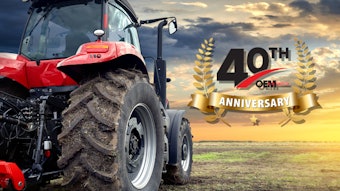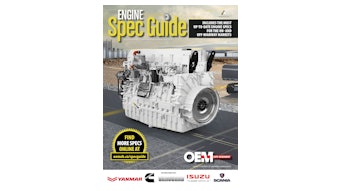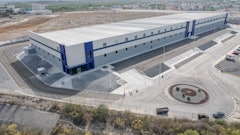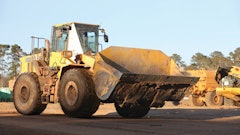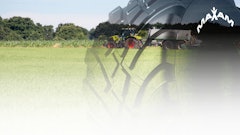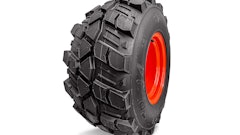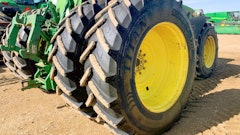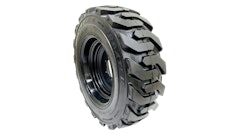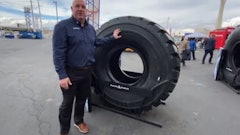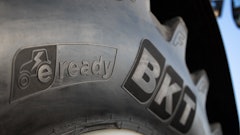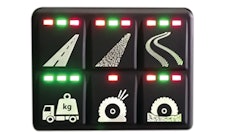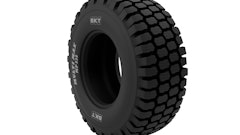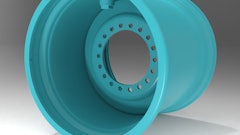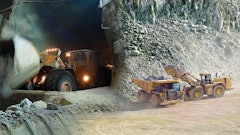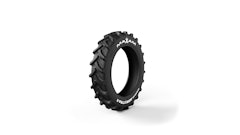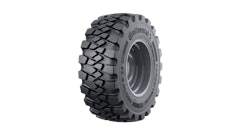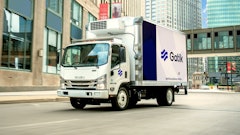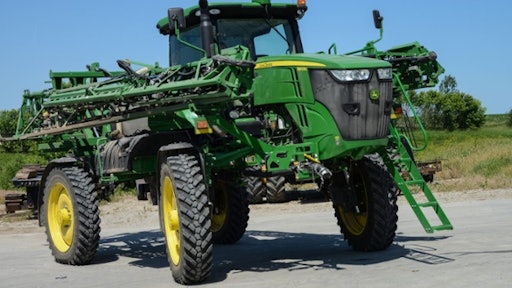
Soil compaction continues to be an area of concern for the agricultural industry as machinery gets larger and field conditions become less predictable. In addition, farmers are having to travel farther between fields and more often. Sprayers in particular are challenged with this as the machines themselves, as well as their load carrying capacity has grown, and they are often traveling from field to field.
Because of this, tire manufacturers have needed to develop tires which both reduce soil compaction and enable travel along roadways. During this year’s Farm Progress Show (FPS), tires designed for this purpose could be seen at many manufacturers' booths. 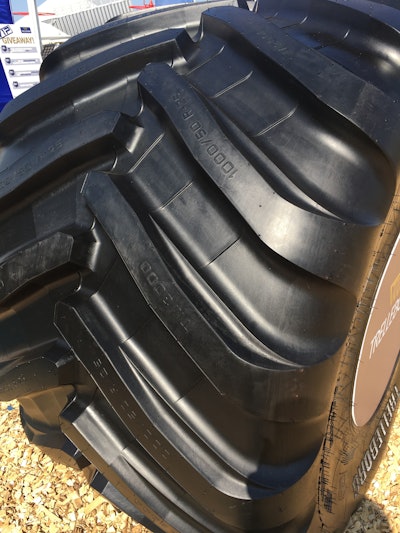 Trelleborg's TM3000 is a VF tire standardized for spreader and sprayer applications with a D rated load index for road speeds of up to 40 mph.S. Jensen
Trelleborg's TM3000 is a VF tire standardized for spreader and sprayer applications with a D rated load index for road speeds of up to 40 mph.S. Jensen
For the reduced soil compaction needs, many over the last several years have developed what are known as IF (increased flexion) or VF (very high flexion) tires which are capable of carrying a higher load than a traditional tire at the same pressure, or can carry the same load but at a lower inflation pressure in order to help reduce soil compaction.
Trelleborg, for instance, exhibited its VF1050/50R32 TM3000 tire with ProgressiveTraction technology. The tire is the company’s first VF tire standardized for spreader and sprayer applications. It features a D rated load index, enabling road speeds of 40 mph (65 km/h); the VF technology allows 40% more load to be carried at the same pressure as a traditional tire or to inflate the tire with up to 40% less pressure while carrying the same load. This means that the tire can carry up to 29,100 lbs. (13,200 kg) at 52 psi (3.6 bar). “The new generation of spreader machines show an increasing need for carrying higher load while constantly reducing the contact pressure on the field to limit soil compaction during spreading operations,” said Lorenzo Ciferri, Marketing Director at Trelleborg Agricultural and Forestry Tires, in a press release announcing the launch of the new tire.
Meanwhile, the ProgressiveTraction technology features a double lug design to provide two bite points on the ground to ensure the tire gets as much traction as possible. There is also an interlug terracing which breaks up mud so the tire is always cleaning itself, further aiding traction.
It’s all in the tread
According to James Crouch, Marketing Specialist at Alliance Tire Americas Inc., standard tractor tire treads have not changed much in 100 years, but the tractors themselves have. Because of this, Alliance Tire knew it needed to evolve its tire tread technology to meet the needs of today’s farmers. The company did so with its new Agriflex 363 VF 380/90R46 row crop tire, a VF tire designed specifically for the North American sprayer market. 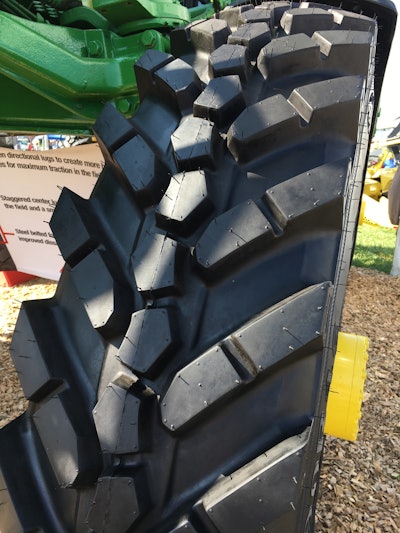 To mitigate heat buildup, the Agriflex 363 features a large tread face to distribute heat over a larger area, as well as more rubber in the contact patch to dissipate heat.S. Jensen
To mitigate heat buildup, the Agriflex 363 features a large tread face to distribute heat over a larger area, as well as more rubber in the contact patch to dissipate heat.S. Jensen
Spayers spend about 50% of their time in the field and 50% on the road, requiring their tires to withstand the heat buildup that can occur when traveling down the road at high speeds while carrying heavy loads. To mitigate heat buildup, the tire features a large tread face to distribute heat over a larger area. It also has a longer footprint created by having a more flexible sidewall, as well as more rubber in the contact patch of the tire to dissipate heat. Steel belts inside the tire also help to reduce heat buildup. Crouch says steel belts serve two purposes—dissipate heat and protect against stubble damage, which is beneficial when the machine is working in the field.
The tread pattern is also an important aspect. For field operations, Crouch says the perfect tire for forward traction is a zero-degree bar like that of a tank track while a straight up and down bar—similar to a two-wheel drive tire—is best for lateral traction, which is beneficial for keeping the tire between crop rows. Alliance’s new 363 includes a blend of both patterns. An outside line along the edge of the tire provides more biting edges to ensure traction in the field while a solid center rib keeps the tire in line between the rows. “It’s like a guide rib; it [performs] basically like a two-wheel drive tire [that stays] true to the row,” says Crouch.
Domenic Mazzola, Vice President Engineering/OE Sales, Alliance Tire Americas Inc., says the 363 also has more lugs which are spaced close together. This helps with a condition called heel toe wear on the lug. He explains that when the lugs are spaced far apart, they can wear oddly on the leading edge of one and the trailing edge of the next as the machine travels down the road. However, having more lugs spaced close together eliminates this.
The tire’s VF technology aids the high load capacity of the machine on which it’s mounted. At FPS, it was exhibited on a 1,000 gal. (3,785.41 L) capacity sprayer, with the tires inflated to about 45 psi (3.10 bar). Crouch says a standard, non-VF tire would be inflated to 64 psi. “There’s a huge difference in pressure which contributes to better operator comfort,” he says.
He also notes the North American sprayer market is the first to really adopt the use of VF technology because it has a higher demand for it, and more challenges which it is able to solve.
Laurent Le Dortz, Director of Marketing, Agricultural and Compact Product Line, Michelin North America Inc., says the reduced soil compaction VF technology provides can lead to increased yields for farmers. He says Michelin conducted a survey with a university in the U.K. and found on average fields in which VF tires were used had a 4% increase in crop yield.
During FPS, the company exhibited several VF tires including its EvoBIB “2-in-1” tire designed to work with central tire inflation systems. This enables operators to easily adjust inflation pressures when going between fields and the road. When inflated to higher pressures for road travel, only the central continuous tread band grips the pavement, resulting in a smoother, vibration-free ride. In addition, Le Dortz says this reduces rolling resistance to help decrease fuel consumption as well as improve tread wear.
Once in the field, tire pressure is decreased which causes the tire shoulder to expand, increasing the tire footprint to aid traction. The tire’s contact patch is increased 20%, helping reduce soil compaction. “It’s a real versatile tire,” says Le Dortz. “We call it ‘2-in-1’ because it has the best performance on the road and in the field.” Michelin expects to launch the tire to the North American market in mid-2018. 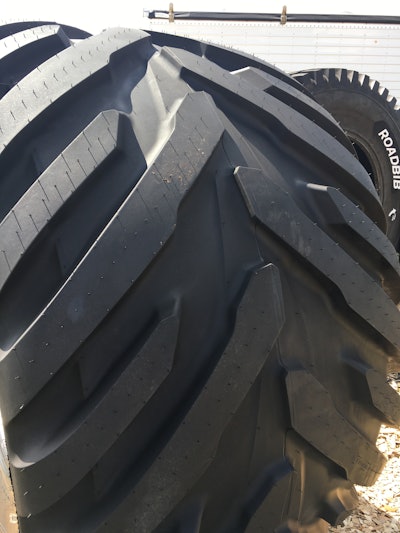 The double lug pattern and increased lug size of the Loadster maximize traction and reduce tread wear.S. Jensen
The double lug pattern and increased lug size of the Loadster maximize traction and reduce tread wear.S. Jensen
The company also exhibited its prototype “Loadster” tire designed for high-speed, high-load capacity applications such as floaters and other heavy equipment. Again, it includes the company’s Ultraflex VF casing to provide reduced soil compaction when working in the field. Le Dortz says this is an important tire for Michelin as it is capable of carrying heavy loads at low inflation pressures—at maximum 14 psi (0.97 bar). The tire can carry 8.5-17 tons, and the goal is to achieve an E speed reading—up to 70 km/h (43.5 mph)—says Le Dortz. Michelin is still developing and testing the tire, and doesn’t expect it to hit the market until 2019.
To withstand high speed and loads the Loadster will face on roadways, Michelin developed a double lug pattern to maximize traction. The lug size has been increased, as well, in areas where tread wear typically appears to help minimize it. The company also designed a block in the middle of the tread to improve stubble resistance. A smooth angle on the nose of the lug prevents stubble from sticking to the tire.
A change in tire shape and mindsets
Scott Sloan, Agricultural Product Manager for Titan and Goodyear Farm Tires, says one of the drawbacks of IF and VF tires is that operators are required to manage the inflation pressure, which they are not always good at doing. Instead, the company has focused efforts on developing its Low Sidewall (LSW) tires which feature a larger rim diameter and shorter sidewall than a traditional tire to reduce road lope and power hop while maintaining the same inflation pressures, load capacities and outside tire diameter. “What’s nice about this is we can bolt on the technology and they get the advantages of the LSW without having to manage the inflation pressures,” says Sloan. All LSWs are designed for VF inflation pressures and can be adjusted if a farmer wants to get the benefits for reduced soil compaction from the tire.
He notes the company has had discussions with OEMs about automated tire inflation systems—which a few companies have developed and begun to deploy—but they can be pricey, adding an additional $10,000-20,000 to the cost of a tractor. Soil compaction is still a difficult issue for many to get their heads around, and unless a concrete value can be placed on how much additional yield can be achieved, the added cost of the inflation system can be difficult for farmers to accept. While they can be helpful, he says the systems are more common in Europe currently. “Again, the advantage of LSW, since we have about a 20% shorter sidewall, and 20% faster fill and deflate, it saves time right off the cuff. Even if the inflation systems come, we’ll have an advantage because they can fill faster, get more air out faster.”
Titan is in the process of expanding its LSW line with additional sizes to fit more applications. Sloan says the conversation with customers has shifted in the last 2-3 years from being about what benefits the tire can provide to whether or not it can fit their machine, prompting the company to develop more sizes. At FPS it displayed its new Goodyear OPTITRAC LSW1100/35R32 and LSW1250/35R46 which offers an approximate 25% improvement to footprint compared to a standard dual setup. 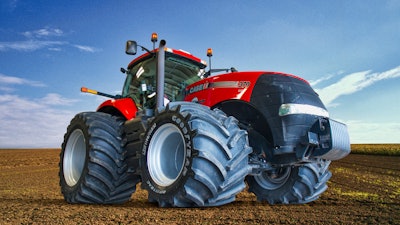 Titan's new Goodyear OPTITRAC LSW1100/35R32 and LSW1250/35R46 offer an approximate 25% improvement to footprint compared to a standard dual setup.Titan Tire Corp.
Titan's new Goodyear OPTITRAC LSW1100/35R32 and LSW1250/35R46 offer an approximate 25% improvement to footprint compared to a standard dual setup.Titan Tire Corp.
Shifting the industry from using duals has been a big push for the company, as well. For many years farmers have thought it necessary to use narrow dual tires to straddle crop rows in order to reduce compaction. However, Titan participated in a study which found using super single LSW tires is capable of providing the desired reduction in soil compaction. Use of these tires also enables farmers to get into the fields sooner, as they are better able to travel through wetter conditions than traditional tires. Sloan says they also provide the benefit of improved ride comfort. It was announced at FPS that New Holland Agriculture will now offer super single LSW tires on its T8 tractor line direct from the factory due in part to seeing results of the field studies. Sloan says this helps legitimize the technology for farmers when they know it can be purchased from the OEM.
Reduced soil compaction is likely to remain an area of concern for tire manufacturers, and OEMs, as a farmer’s need to get into the field sooner continues to grow due to changing field conditions and increased crop production requirements. With the tire technologies already developed, and those underway, manufacturers will be better equipped to meet these needs, which will in turn better help farmers feed an ever-increasing world population.
